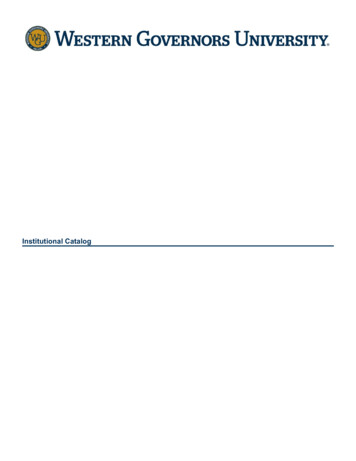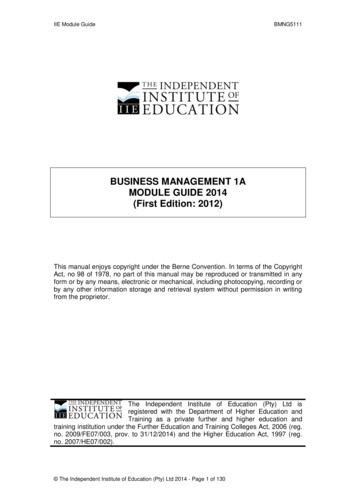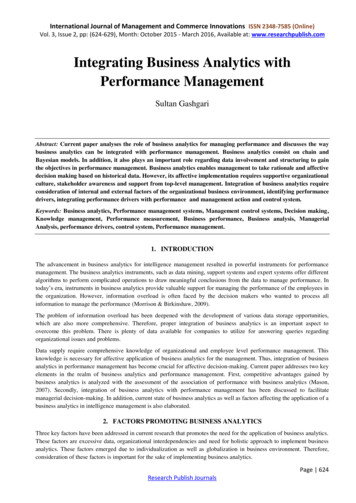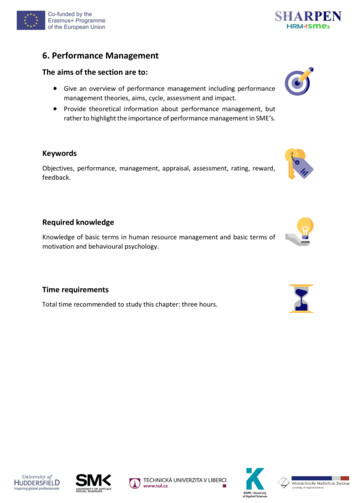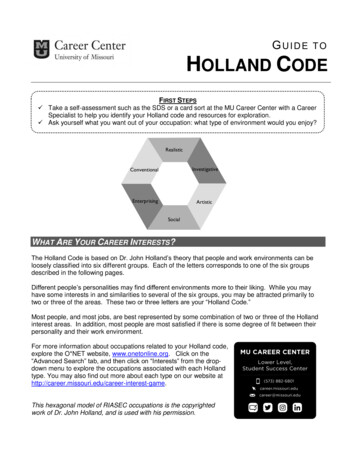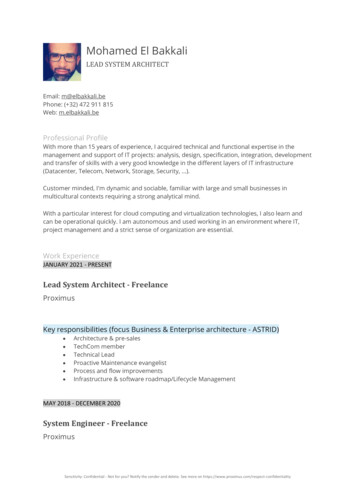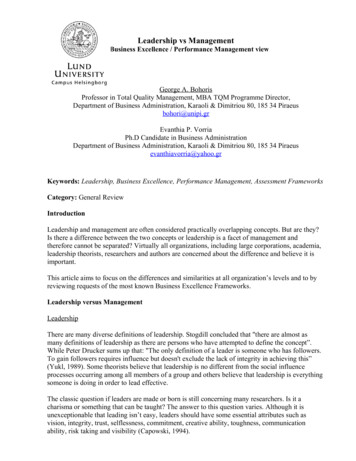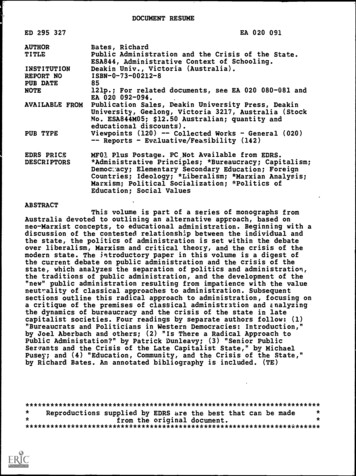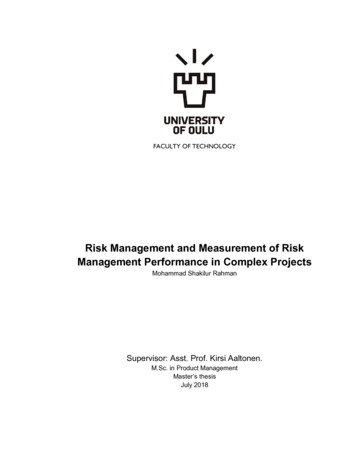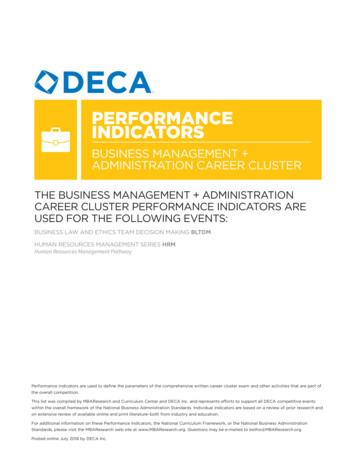
Transcription
PERFORMANCEINDICATORSBUSINESS MANAGEMENT ADMINISTRATION CAREER CLUSTERTHE BUSINESS MANAGEMENT ADMINISTRATIONCAREER CLUSTER PERFORMANCE INDICATORS AREUSED FOR THE FOLLOWING EVENTS:BUSINESS LAW AND ETHICS TEAM DECISION MAKING BLTDMHUMAN RESOURCES MANAGEMENT SERIES HRMHuman Resources Management PathwayPerformance indicators are used to define the parameters of the comprehensive written career cluster exam and other activities that are part ofthe overall competition.This list was compiled by MBAResearch and Curriculum Center and DECA Inc. and represents efforts to support all DECA competitive eventswithin the overall framework of the National Business Administration Standards. Individual indicators are based on a review of prior research andon extensive review of available online and print literature–both from industry and education.For additional information on these Performance Indicators, the National Curriculum Framework, or the National Business AdministrationStandards, please visit the MBAResearch web site at www.MBAResearch.org. Questions may be e-mailed to betho@MBAResearch.org.Posted online July 2016 by DECA Inc.
TABLE OF CONTENTSTier 1: Business Administration Core. 3Tier 2: Business Management and Administration Career Cluster . 22Tier 3: Business Management and Administration Career PathwaysAdministrative Services Pathway. 29Business Information Management Pathway. 35General Management Pathway . 40Human Resources Management Pathway. 45Operations Pathway . 52Performance Indicators Performance indicators for PRINCIPLES OF BUSINESS ADMINISTRATION role-plays and exams will beselected from the business administration core (Tier 1). Performance indicators for TEAM DECISION MAKING case studies and exams will be selected from thebusiness administration core (Tier 1) and appropriate career cluster (Tier 2). Performance indicators for INDIVIDUAL SERIES exams will be selected from the business administrationcore (Tier 1) and appropriate career cluster (Tier 2). Performance indicators for the role-plays will beselected from the business administration core (Tier 1), appropriate career cluster (Tier 2) andappropriate pathway (Tier 3).KeyPQ Prerequisite level performance indicator content develops employability and job-survival skills andconcepts, including work ethics, personal appearance, and general business behavior.CS Career Sustaining level performance indicator content develops skills and knowledge needed for continuedemployment in or study of business based on the application of basic academics and business skills.SP Specialist level performance indicator content provides in-depth, solid understanding and skilldevelopment in all business functions.
Tier 1: Business Administration CorePage 3The business administration core performance indicators will be used when preparing for allexams, role-play scenarios, and case studies in the following events: Business Law and Ethics Decision MakingHuman Resources Management SeriesBusiness Management and Administration Cluster (PQ, CS, SP) Copyright 2015, MBA Research and Curriculum Center
Tier 1: Business Administration CorePage 4Instructional Area: Business Law (BL)Standard: Understands business's responsibility to know, abide by, and enforce laws andregulations that affect business operations and transactionsPerformance Element: Acquire foundational knowledge of business laws and regulations tounderstand their nature and scope.Performance Indicators:Discuss the nature of law and sources of law in the United States (SP)Describe the United States' judicial system (SP)Describe methods used to protect intellectual property (SP)Describe legal issues affecting businesses (SP)Performance Element: Understand the civil foundations of the legal environment of businessto demonstrate knowledge of contracts.Performance Indicators:Identify the basic torts relating to business enterprises (SP)Describe the nature of legally binding contracts (SP)Performance Element: Explore the regulatory environment of United States' businesses tounderstand the diversity of regulations.Performance Indicators:Describe the nature of legal procedure (SP)Discuss the nature of debtor-creditor relationships (SP)Explain the nature of agency relationships (SP)Discuss the nature of environmental law (SP)Discuss the role of administrative law (SP)Performance Element: Apply knowledge of business ownership to establish and continuebusiness operations.Performance Indicators:Explain types of business ownership (CS)Performance Element: Acquire knowledge of commerce laws and regulations to continuebusiness operations.Performance Indicators:Explain the nature of import/export law (SP)Describe the nature of customs regulations (SP)
Tier 1: Business Administration CorePage 5Instructional Area: Communication Skills (CO)Standard: Understands the concepts, strategies, and systems used to obtain and convey ideasand informationPerformance Element: Read to acquire meaning from written material and to apply theinformation to a task.Performance Indicators:Identify sources that provide relevant, valid written material (PQ)Extract relevant information from written materials (PQ)Apply written directions to achieve tasks (PQ)Analyze company resources to ascertain policies and procedures (CS)Performance Element: Apply active listening skills to demonstrate understanding of what isbeing said.Performance Indicators:Explain communication techniques that support and encourage a speaker (PQ)Follow oral directions (PQ)Demonstrate active listening skills (PQ)Performance Element: Apply verbal skills to obtain and convey information.Performance Indicators:Explain the nature of effective verbal communications (PQ)Ask relevant questions (PQ)Interpret others' nonverbal cues (PQ)Provide legitimate responses to inquiries (PQ)Give verbal directions (PQ)Employ communication styles appropriate to target audience (CS)Defend ideas objectively (CS)Handle telephone calls in a businesslike manner (CS)Participate in group discussions (CS)Facilitate (lead) group discussions (SP)Make oral presentations (SP)Performance Element: Record information to maintain and present a report of businessactivity.Performance Indicators:Utilize note-taking strategies (CS)Organize information (CS)Select and use appropriate graphic aids (CS)
Tier 1: Business Administration CorePage 6Performance Element: Write internal and external business correspondence to convey andobtain information effectively.Performance Indicators:Explain the nature of effective written communications (CS)Select and utilize appropriate formats for professional writing (CS)Edit and revise written work consistent with professional standards (CS)Write professional e-mails (CS)Write business letters (CS)Write informational messages (CS)Write inquiries (CS)Write persuasive messages (SP)Write executive summaries (SP)Prepare simple written reports (SP)Explain how digital communications (e.g., email, text messages, chats) exposes business to risk(SP)Adapt written correspondence to targeted audiences (SP)Use data visualization techniques (e.g., infographics, linked charts, etc.) (SP)Performance Element: Use social media to communicate with a business’s stakeholders.Performance Indicators:Describe the impact of a person’s social media brand on the achievement of organizationalobjectives (CS)Distinguish between using social media for business and personal purposes (CS)Performance Element: Communicate with staff to clarify workplace objectives.Performance Indicators:Explain the nature of staff communication (CS)Choose and use appropriate channel for workplace communication (CS)Participate in a staff meeting (CS)Participate in problem-solving groups (CS)
Tier 1: Business Administration CorePage 7Instructional Area: Customer Relations (CR)Standard: Understands the techniques and strategies used to foster positive, ongoingrelationships with customersPerformance Element: Foster positive relationships with customers to enhance companyimage.Performance Indicators:Explain the nature of positive customer relations (CS)Demonstrate a customer-service mindset (CS)Develop rapport with customers (CS)Reinforce service orientation through communication (CS)Respond to customer inquiries (CS)Adapt communication to the cultural and social differences among clients (CS)Interpret business policies to customers/clients (CS)Build and maintain relationships with customers (SP)Performance Element: Resolve conflicts with/for customers to encourage repeat business.Performance Indicators:Handle difficult customers (CS)Handle customer/client complaints (CS)Performance Element: Reinforce company's image to exhibit the company's brand promise.Performance Indicators:Identify company's brand promise (CS)Determine ways of reinforcing the company's image through employee performance (CS)Performance Element: Understand the nature of customer relationship management to showits contributions to a company.Performance Indicators:Discuss the nature of customer relationship management (SP)Explain the role of ethics in customer relationship management (SP)Describe the use of technology in customer relationship management (SP)
Tier 1: Business Administration CorePage 8Instructional Area: Economics (EC)Standard: Understands the economic principles and concepts fundamental to businessoperationsPerformance Element: Understand fundamental economic concepts to obtain a foundationfor employment in business.Performance Indicators:Distinguish between economic goods and services (CS)Explain the concept of economic resources (CS)Describe the concepts of economics and economic activities (CS)Determine economic utilities created by business activities (CS)Explain the principles of supply and demand (CS)Describe the functions of prices in markets (CS)Performance Element: Understand the nature of business to show its contributions to society.Performance Indicators:Explain the role of business in society (CS)Describe types of business activities (CS)Describe types of business models (SP)Explain the organizational design of businesses (SP)Discuss the global environment in which businesses operate (SP)Describe factors that affect the business environment (SP)Explain the nature of business ethics (SP)Explain how organizations adapt to today's markets (SP)Performance Element: Understand economic systems to be able to recognize theenvironments in which businesses function.Performance Indicators:Explain the types of economic systems (CS)Identify the impact of small business/entrepreneurship on market economies (CS)Explain the concept of private enterprise (CS)Identify factors affecting a business's profit (CS)Determine factors affecting business risk (CS)Explain the concept of competition (CS)Performance Element: Acquire knowledge of the impact of government on business activitiesto make informed economic decisions.Performance Indicators:Determine the relationship between government and business (CS)Describe the nature of taxes (SP)
Tier 1: Business Administration CorePage 9Performance Element: Analyze cost/profit relationships to guide business decision-making.Performance Indicators:Explain the concept of productivity (CS)Analyze impact of specialization/division of labor on productivity (SP)Explain the concept of organized labor and business (SP)Explain the impact of the law of diminishing returns (SP)Performance Element: Understand economic indicators to recognize economic trends andconditions.Performance Indicators:Discuss the measure of consumer spending as an economic indicator (SP)Describe the economic impact of inflation on business (SP)Explain the concept of Gross Domestic Product (GDP) (SP)Discuss the impact of a nation's unemployment rates (SP)Explain the economic impact of interest-rate fluctuations (SP)Determine the impact of business cycles on business activities (SP)Performance Element: Understand global trade's impact to aid business decision-making.Performance Indicators:Explain the nature of global trade (SP)Discuss the impact of globalization on business (SP)Describe the determinants of exchange rates and their effects on the domestic economy (SP)Explain cultural considerations that impact global business relations (SP)Discuss the impact of cultural and social environments on global trade (SP)Describe the impact of electronic communication tools (e.g., Internet, video- and computerconferencing, webcasts, email) on global business activities (SP)Explain the impact of major trade alliances on business activities (SP)Describe the impact of the political environment on world trade (SP)Explain the impact of geography on world trade (SP)Describe the impact of a country's history on world trade (SP)Explain the impact of a country's economic development on world trade (SP)Discuss the impact of bribery and foreign monetary payments on business (SP)Identify requirements for international business travel (e.g., passport, visa, proof of citizenship,immunizations, and sponsorship letters) (SP)
Tier 1: Business Administration CorePage 10Instructional Area: Emotional Intelligence (EI)Standard: Understands techniques, strategies, and systems used to foster self-understandingand enhance relationships with othersPerformance Element: Foster self-understanding to recognize the impact of personal feelingson others.Performance Indicators:Describe the nature of emotional intelligence (PQ)Explain the concept of self-esteem (PQ)Recognize personal biases and stereotypes (PQ)Assess personal strengths and weaknesses (PQ)Performance Element: Develop personal traits to foster career advancement.Performance Indicators:Identify desirable personality traits important to business (PQ)Exhibit self-confidence (PQ)Demonstrate interest and enthusiasm (PQ)Demonstrate initiative (PQ)Performance Element: Apply ethics to demonstrate trustworthiness.Performance Indicators:Demonstrate responsible behavior (PQ)Demonstrate honesty and integrity (PQ)Demonstrate ethical work habits (PQ)Take responsibility for decisions and actions (PQ)Manage commitments in a timely manner (CS)Performance Element: Exhibit techniques to manage emotional reactions to people andsituations.Performance Indicators:Exhibit a positive attitude (PQ)Demonstrate self-control (PQ)Explain the use of feedback for personal growth (PQ)Adjust to change (PQ)Performance Element: Identify with others' feelings, needs, and concerns to enhanceinterpersonal relations.Performance Indicators:Respect the privacy of others (PQ)Show empathy for others (PQ)Maintain the confidentiality of others (CS)Exhibit cultural sensitivity (CS)Leverage personality types in business situations (SP)
Tier 1: Business Administration CorePage 11Performance Element: Use communication skills to foster open, honest communications.Performance Indicators:Explain the nature of effective communications (PQ)Explain ethical considerations in providing information (SP)Solicit feedback (SP)Use social media to solicit new ideas and solutions (SP)Performance Element: Use communication skills to influence others.Performance Indicators:“Sell” ideas to others (SP)Persuade others (SP)Demonstrate negotiation skills (SP)Performance Element: Manage stressful situations to minimize potential negative impact.Performance Indicators:Use appropriate assertiveness (PQ)Use conflict-resolution skills (CS)Explain the nature of office politics (CS)Overcome problems and difficulties associated with office politics/turf wars (CS)Explain the nature of stress management (SP)Performance Element: Implement teamwork techniques to accomplish goals.Performance Indicators:Participate as a team member (CS)Use consensus-building skills (SP)Motivate team members (SP)Performance Element: Employ leadership skills to achieve workplace objectives.Performance Indicators:Explain the concept of leadership (CS)Determine personal vision (CS)Demonstrate adaptability (CS)Develop an achievement orientation (CS)Lead change (CS)Enlist others in working toward a shared vision (CS)Coach others (CS)
Tier 1: Business Administration CorePage 12Performance Element: Manage internal and external business relationships to foster positiveinteractions.Performance Indicators:Treat others fairly at work (PQ)Foster positive working relationships (CS)Maintain collaborative partnerships with colleagues (SP)Explain the impact of political relationships within an organization (SP)Explain the nature of organizational culture (SP)Interpret and adapt to a business’s culture (SP)Instructional Area: Entrepreneurship (EN)Standard: Understands the concepts, processes, and skills associated with identifying newideas, opportunities, and methods and with creating or starting a new project or venturePerformance Element: Understand fundamental factors about entrepreneurship to recognizeits role and importance in the economyPerformance Indicators:Describe the nature of entrepreneurship (SP)Explain the role requirements of entrepreneurs and owners (SP)Describe small-business opportunities in international trade (SP)Instructional Area: Financial Analysis (FI)Standard: Understands tools, strategies, and systems used to maintain, monitor, control, andplan the use of financial resourcesPerformance Element: Understand the fundamental principles of money needed to makefinancial exchanges.Performance Indicators:Explain forms of financial exchange (cash, credit, debit, electronic funds transfer, etc.) (PQ)Identify types of currency (paper money, coins, banknotes, government bonds, treasury notes,etc.) (PQ)Describe functions of money (medium of exchange, unit of measure, store of value) (PQ)Describe sources of income (wages/salaries, interest, rent, dividends, transfer payments, etc.)(PQ)Explain the time value of money (CS)Explain the purposes and importance of credit (CS)Explain legal responsibilities associated with financial exchanges (CS)
Tier 1: Business Administration CorePage 13Performance Element: Analyze financial needs and goals to determine financial requirements.Performance Indicators:Explain the nature of financial needs (e.g., college, retirement, wills, insurance, etc.) (CS)Set financial goals (CS)Develop personal budget (CS)Performance Element: Manage personal finances to achieve financial goals.Performance Indicators:Explain the nature of tax liabilities (PQ)Interpret a pay stub (PQ)Prepare bank account documents (e.g., checks, deposit/withdrawal slips, endorsements, etc.)(PQ)Maintain financial records (PQ)Read and reconcile bank statements (PQ)Demonstrate the wise use of credit (CS)Validate credit history (CS)Protect against identity theft (CS)Prepare personal income tax forms (i.e., 1040 EZ form) (CS)Performance Element: Understand the use of financial-services providers to aid in financialgoal achievement.Performance Indicators:Describe types of financial-services providers (CS)Discuss considerations in selecting a financial-services provider (CS)Performance Element: Use investment strategies to ensure financial well-being.Performance Indicators:Explain types of investments (CS)Performance Element: Use risk management products to protect a business’s financial wellbeing.Performance Indicators:Describe the concept of insurance (CS)Performance Element: Acquire a foundational knowledge of accounting to understand itsnature and scope.Performance Indicators:Describe the need for financial information (CS)Explain the concept of accounting (CS)Discuss the role of ethics in accounting (SP)Explain the use of technology in accounting (SP)Explain legal considerations for accounting (SP)
Tier 1: Business Administration CorePage 14Performance Element: Implement accounting procedures to track money flow and todetermine financial status.Performance Indicators:Describe the nature of cash flow statements (SP)Explain the nature of balance sheets (SP)Describe the nature of income statements (SP)Performance Element: Acquire a foundational knowledge of finance to understand its natureand scope.Performance Indicators:Explain the role of finance in business (CS)Discuss the role of ethics in finance (SP)Explain legal considerations for finance (SP)Performance Element: Manage financial resources to ensure solvency.Performance Indicators:Describe the nature of budgets (SP)Instructional Area: Human Resources Management (HR)Standard: Understands the tools, techniques, and systems that businesses use to plan, staff,lead, and organize its human resourcesPerformance Element: Understand the role and function of human resources management toobtain a foundational knowledge of its nature and scope.Performance Indicators:Discuss the nature of human resources management (CS)Explain the role of ethics in human resources management (SP)Describe the use of technology in human resources management (SP)Performance Element: Manage staff growth and development to increase productivity andemployee satisfaction.Performance Indicators:Orient new employees (CS)
Tier 1: Business Administration CorePage 15Instructional Area: Marketing (MK)Standard: Understands the tools, techniques, and systems that businesses use to createexchanges and satisfy organizational objectivesPerformance Element: Understand marketing's role and function in business to facilitateeconomic exchanges with customers.Performance Indicators:Explain marketing and its importance in a global economy (CS)Describe marketing functions and related activities (CS)Performance Element: Acquire foundational knowledge of customer/client/business behaviorto understand what motivates decision-making.Performance Indicators:Explain factors that influence customer/client/business buying behavior (SP)Discuss actions employees can take to achieve the company's desired results (SP)Demonstrate connections between company actions and results (e.g., influencing consumerbuying behavior, gaining market share, etc.) (SP)Instructional Area: Information Management (NF)Standard: Understands tools, strategies, and systems needed to access, process, maintain,evaluate, and disseminate information to assist business decision-makingPerformance Element: Use information literacy skills to increase workplace efficiency andeffectiveness.Performance Indicators:Assess information needs (CS)Obtain needed information efficiently (CS)Evaluate quality and source of information (CS)Apply information to accomplish a task (CS)Store information for future use (CS)Performance Element: Acquire a foundational knowledge of information management tounderstand its nature and scope.Performance Indicators:Discuss the nature of information management (CS)Explain the role of ethics in information management (SP)Explain legal issues associated with information management (SP)
Tier 1: Business Administration CorePage 16Performance Element: Utilize information-technology tools to manage and perform workresponsibilities.Performance Indicators:Identify ways that technology impacts business (PQ)Explain the role of information systems (PQ)Discuss principles of computer systems (PQ)Use basic operating systems (PQ)Describe the scope of the Internet (PQ)Demonstrate basic e-mail functions (PQ)Demonstrate personal information management/productivity applications (PQ)Demonstrate basic web-search skills (PQ)Demonstrate basic word processing skills (PQ)Demonstrate basic presentation applications (PQ)Demonstrate basic database applications (PQ)Demonstrate basic spreadsheet applications (PQ)Use an integrated business software application package (CS)Demonstrate collaborative/groupware applications (CS)Create and post basic web page (CS)Collaborate on and aggregate complex internal documents to create a common voice (SP)Performance Element: Maintain business records to facilitate business operations.Performance Indicators:Describe the nature of business records (SP)Maintain customer records (SP)Performance Element: Acquire information to guide business decision-making.Performance Indicators:Describe current business trends (SP)Monitor internal records for business information (SP)Conduct an environmental scan to obtain business information (SP)Interpret statistical findings (SP)Translate research findings into actionable business recommendations (SP)Performance Element: Create and access databases to acquire information for businessdecision-making.Performance Indicators:Explain the principles of data analysis (SP)Explain the nature of tools that can be used to access information in the database system (SP)Access information in the database system (SP)
Tier 1: Business Administration CorePage 17Performance Element: Apply data mining methods to acquire pertinent information forbusiness decision-making.Performance Indicators:Discuss the nature of data mining (CS)Describe data mining tools and techniques (SP)Discuss the importance of ethics in data mining (SP)Demonstrate basic data mining techniques (SP)Interpret data mining findings (SP)Instructional Area: Operations (OP)Standard: Understands the processes and systems implemented to monitor, plan, and controlthe day-to-day activities required for continued business functioningPerformance Element: Understand operation's role and function in business to value itscontribution to a company.Performance Indicators:Explain the nature of operations (CS)Discuss the role of ethics in operations (SP)Describe the use of technology in operations (SP)Performance Element: Adhere to health and safety regulations to support a safe workenvironment.Performance Indicators:Describe health and safety regulations in business (PQ)Report noncompliance with business health and safety regulations (PQ)Performance Element: Implement safety procedures to minimize loss.Performance Indicators:Follow instructions for use of equipment, tools, and machinery (PQ)Follow safety precautions (PQ)Maintain a safe work environment (CS)Explain procedures for handling accidents (CS)Handle and report emergency situations (CS)Performance Element: Implement security policies/procedures to minimize chance for loss.Performance Indicators:Explain routine security precautions (CS)Follow established security procedures/policies (CS)Protect company information and intangibles (CS)
Tier 1: Business Administration CorePage 18Performance Element: Comply with security rules, regulations, and codes (e.g., property,privacy, access, confidentiality) to protect customer and company information, reputation,and image.Performance Indicators:Explain information privacy, security, and confidentiality considerations in business (CS)Maintain data security (CS)Performance Element: Utilize project-management skills to improve workflow and minimizecosts.Performance Indicators:Explain the nature of project management (SP)Identify resources needed for project (SP)Develop project plan (SP)Apply project-management tools to monitor and communicate project progress (SP)Evaluate project results (SP)Performance Element: Implement purchasing activities to obtain business supplies,equipment, resources, and services.Performance Indicators:Explain the nature and scope of purchasing (CS)Place orders/reorders (CS)Maintain inventory of supplies (CS)Discuss the importance of utilizing ethical purchasing methods (SP)Explain the impact of the purchasing process on productivity (SP)Manage the bid process in purchasing (SP)Select vendors (SP)Evaluate vendor performance (SP)Performance Element: Understand production's role and function in business to recognize itsneed in an organization.Performance Indicators:Explain the concept of production (CS)Performance Element: Implement quality-control processes to minimize errors and toexpedite workflow.Performance Indicators:Identify quality-control measures (SP)Utilize quality control methods at work (SP)Describe crucial elements of a quality culture (SP)Performance Element: Implement expense-control strategies to enhance a business'sfinancial wellbeing.Performance Indicators:
Tier 1: Business Administration CorePage 19Explain the nature of overhead/operating costs (SP)Explain employee's role in expense control (SP)Performance Element: Maintain property and equipment to facilitate ongoing businessactivities.Performance Indicators:Comply with policies and procedures for use of property and equipment (CS)Performance Element: Understand supply chain management role to recognize its need inbusiness.Performance Indicators:Explain the concept of supply chain (CS)Explain the benefits of supply chain collaboration (SP)Instructional Area: Professional Development (PD)Standard: Understands concepts, tools, and strategies used to explore, obtain, and develop ina business careerPerformance Element: Acquire self-development skills to enhance relationships and improveefficiency in the work environment.Performance Indicators:Maintain appropriate personal appearance (PQ)Demonstrate systematic behavior (PQ)Set personal goals (CS)Balance personal and professional responsibilities (SP)Performance Element: Understand and follow company rules and regulations to maintainemployment.Performance Indicators:Adhere to company protocols and policies (CS)Follow rules of conduct (CS)Follow chain of command (CS)Performance Element: Achieve organizational goals to contribute to company growth.Performance Indicators:Determine the nature of organizational goals (SP)Ascertain employee's role in meeting organizational goa
Instructional Area: Business Law (BL) Standard: Understands business's responsibility to know, abide by, and enforce laws and regulations that affect business operations and transactions Performance Element: Acquire foundational knowledge of business laws and regulations to understand their nature and scope. Performance Indicators:
